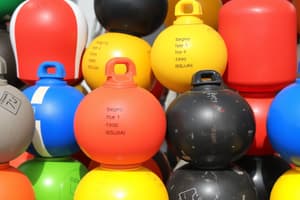Podcast
Questions and Answers
1.A boatman is stationed at a point on one bank of a river of width 1 km. The river is flowing at 5 km/ h and the boatman can row with a speed of 10 km/h in still water. In which direction should the boatman row in order to reach a point on the other bank in the shortest possible time?
1.A boatman is stationed at a point on one bank of a river of width 1 km. The river is flowing at 5 km/ h and the boatman can row with a speed of 10 km/h in still water. In which direction should the boatman row in order to reach a point on the other bank in the shortest possible time?
- (1) At 30° to the direction of flow 2√3
- (2) At 60° to the direction of flow
- (3) At 90° to the direction of flow
- (4) At 120° to the direction of flow (correct)
2.A car takes 12 hours to go from place A to place B. Every hour one car starts from each place to reach the other place. How many cars does each car meet on the road (excluding the places A and B)?
2.A car takes 12 hours to go from place A to place B. Every hour one car starts from each place to reach the other place. How many cars does each car meet on the road (excluding the places A and B)?
- (1) 12
- (2) 13
- (3) 23 (correct)
- (4) 24
3.A block of mass 5 kg is placed on a horizontal surface, and a pushing force of 20 N is acting on a the block as shown in the figure. The coefficient of friction between the block and the surface is 0.2. Then the force of friction between the block and the surface is (Take g = 10 m/s²)
3.A block of mass 5 kg is placed on a horizontal surface, and a pushing force of 20 N is acting on a the block as shown in the figure. The coefficient of friction between the block and the surface is 0.2. Then the force of friction between the block and the surface is (Take g = 10 m/s²)
- (1) 3.2
- (2) 6.4
- (3) 9.6
- (4) 12.8 (correct)
- A particle is lying at a point O inside the rough surface of a cone which is rotating with a constant angular velocity about its axis which is vertical.
The net force on the particle is
- A particle is lying at a point O inside the rough surface of a cone which is rotating with a constant angular velocity about its axis which is vertical. The net force on the particle is
- Two identical cylindrical vessels with their bases at the same level, each contains a liquid of density p. The height of the liquid in one vessel is h_{1} and that in the other is h_{2} The area of either base is A. The work done by gravity in equalizing the levels when the vessels are interconnected
- Two identical cylindrical vessels with their bases at the same level, each contains a liquid of density p. The height of the liquid in one vessel is h_{1} and that in the other is h_{2} The area of either base is A. The work done by gravity in equalizing the levels when the vessels are interconnected
A boatman is stationed at a point on one bank of a river of width 1 km. The river is flowing at 5 km/ h and the boatman can row with a speed of 10 km/h in still water. In which direction should the boatman row in order to reach a point on the other bank in the shortest possible time?
A boatman is stationed at a point on one bank of a river of width 1 km. The river is flowing at 5 km/ h and the boatman can row with a speed of 10 km/h in still water. In which direction should the boatman row in order to reach a point on the other bank in the shortest possible time?
- A car takes 12 hours to go from place A to place B. Every hour one car starts from each place to reach the other place. How many cars does each car meet on the road (excluding the places A and B)?
- A car takes 12 hours to go from place A to place B. Every hour one car starts from each place to reach the other place. How many cars does each car meet on the road (excluding the places A and B)?
A block of mass 5 kg is placed on a horizontal surface, and a pushing force of 20 N is acting on a the block as shown in the figure. The coefficient of friction between the block and the surface is 0.2. Then the force of friction between the block and the surface is (Take g = 10 m/s²)
A block of mass 5 kg is placed on a horizontal surface, and a pushing force of 20 N is acting on a the block as shown in the figure. The coefficient of friction between the block and the surface is 0.2. Then the force of friction between the block and the surface is (Take g = 10 m/s²)
- A particle is lying at a point O inside the rough surface of a cone which is rotating with a constant angular velocity about its axis which is vertical. The net force on the particle is
- A particle is lying at a point O inside the rough surface of a cone which is rotating with a constant angular velocity about its axis which is vertical. The net force on the particle is
- A neutron collides head-on and elastically with an atom of mass number A, which is initially at rest. The fraction of kinetic energy retained by the neutron is:
- A neutron collides head-on and elastically with an atom of mass number A, which is initially at rest. The fraction of kinetic energy retained by the neutron is:
- A ball, moving horizontally with speed v, strikes the bob of a simple pendulum at rest. The mass of the bob is equal to that of the ball If the collision is elastic, the bob will rise to a height:
- A ball, moving horizontally with speed v, strikes the bob of a simple pendulum at rest. The mass of the bob is equal to that of the ball If the collision is elastic, the bob will rise to a height:
- A cord is wound round the circumference of a wheel of radius r. The axis of the wheel is horizontal and its moment of inertia about this axis is I. A weight mg is attached to the end of the chord and is allowed to fall from rest. The angular velocity of the wheel, when the weight has fallen through a distance his
- A cord is wound round the circumference of a wheel of radius r. The axis of the wheel is horizontal and its moment of inertia about this axis is I. A weight mg is attached to the end of the chord and is allowed to fall from rest. The angular velocity of the wheel, when the weight has fallen through a distance his
- Two particles, having mass m, and m., start moving towards each other from rest from infinite separation under gravitational attraction. Their relative velocity of approach at separation r is
- Two particles, having mass m, and m., start moving towards each other from rest from infinite separation under gravitational attraction. Their relative velocity of approach at separation r is
10
Three simple harmonic motions in the same direction having the same amplitude a and same period are superposed. Each differs in phase from the next by 45 deg Then the resultant amplitude is:
10
Three simple harmonic motions in the same direction having the same amplitude a and same period are superposed. Each differs in phase from the next by 45 deg Then the resultant amplitude is:
. A horizontal overhead powerline is at a height of 4 m from the ground and carries a current of 100 A from east to west. The magnetic field directly below it on the ground is ( mu 0 =4 pi sqrt * 10 ^ - 7 * Tm * A ^ - 1 )
. A horizontal overhead powerline is at a height of 4 m from the ground and carries a current of 100 A from east to west. The magnetic field directly below it on the ground is ( mu 0 =4 pi sqrt * 10 ^ - 7 * Tm * A ^ - 1 )
An electric charge +q moves with velocity V=3i+4j+k in an electromagnetic field given by:
↓ E=3i+j+2k and B=i+j-3k.
The y-component of the force experienced by +q is:
An electric charge +q moves with velocity V=3i+4j+k in an electromagnetic field given by:
↓ E=3i+j+2k and B=i+j-3k.
The y-component of the force experienced by +q is:
- The core of an electromagnet is made of soft iron because soft iron has
- The core of an electromagnet is made of soft iron because soft iron has
- Two ferromagnetic materials X and Y have hysteresis curves of the shape shown
- Two ferromagnetic materials X and Y have hysteresis curves of the shape shown
- A coil of cross-sectional area 400c * m ^ 2 having 30 tums is making 1800 rev/min in a magnetic field of 1 T. The peak value of the induced emf is:
- A coil of cross-sectional area 400c * m ^ 2 having 30 tums is making 1800 rev/min in a magnetic field of 1 T. The peak value of the induced emf is:
- A copper rod of length / is rotated about one end perpendicular to a magnetic field B with constant angular velocity a. The induced emf berween the two ends is:
- A copper rod of length / is rotated about one end perpendicular to a magnetic field B with constant angular velocity a. The induced emf berween the two ends is:
When the current in a coil changes from to2 A in 0.05 s, an emf of 8 V is induced in the coil. The coefficient of self-induction of the coil is:
When the current in a coil changes from to2 A in 0.05 s, an emf of 8 V is induced in the coil. The coefficient of self-induction of the coil is:
- An emf of 15 V is applied in a circuit containing 5 H inductance and 10 2 resistance. The ratio of the currents at time t = ∞ and at t = 1s is
- An emf of 15 V is applied in a circuit containing 5 H inductance and 10 2 resistance. The ratio of the currents at time t = ∞ and at t = 1s is
- Two resistors of 10 2 and 20 2 and an ideal inductor of 10 H are connected to a 2 V battery as shown. The key K is inserted at time t = 0 The current through the battery at t = ∞ is:
- Two resistors of 10 2 and 20 2 and an ideal inductor of 10 H are connected to a 2 V battery as shown. The key K is inserted at time t = 0 The current through the battery at t = ∞ is:
- In the given circuit, R = 102 is a pure resistor, L is a pure inductor, S is a 100 V, 50 Hz AC source, and A is an AC ammeter. With either K, or K, alone closed, the ammeter reading is I. Then 'L' is:
- In the given circuit, R = 102 is a pure resistor, L is a pure inductor, S is a 100 V, 50 Hz AC source, and A is an AC ammeter. With either K, or K, alone closed, the ammeter reading is I. Then 'L' is:
- A 50 He ac. source of 20 volts is connected nerons Rand Cas shown in figure below. The voltage across R is 12 volts. The voltage across Cis
- A 50 He ac. source of 20 volts is connected nerons Rand Cas shown in figure below. The voltage across R is 12 volts. The voltage across Cis
- An air bubble inside a glass slab (1-1.5) appears to be 6 cm deep when viewed from one side and 4 em deep when viewed from the opposite side. The thickness of the slab is
- An air bubble inside a glass slab (1-1.5) appears to be 6 cm deep when viewed from one side and 4 em deep when viewed from the opposite side. The thickness of the slab is
- A real image formed by a concave mirrorlis (1.5 times the size of the object. If the mirror is 20 cm) from the object, its focal length is
- A real image formed by a concave mirrorlis (1.5 times the size of the object. If the mirror is 20 cm) from the object, its focal length is
- A hollow metal sphere of radius 5 cm is charged so that the potential on its surface is 10 V/11 potential at the centre of the sphere is
- A hollow metal sphere of radius 5 cm is charged so that the potential on its surface is 10 V/11 potential at the centre of the sphere is
- A screen is placed 180 cm from an object. The image of the object on the screen is forn formed by a convex lens at two different locations separated by 40 cm. The focal length of the lens is nearly equal to:
- A screen is placed 180 cm from an object. The image of the object on the screen is forn formed by a convex lens at two different locations separated by 40 cm. The focal length of the lens is nearly equal to:
- The least distance of distinct vision is 25 cm. The focal length of a convex lens is 5 cm. It can act as a simple microscope of maximum magnification
- The least distance of distinct vision is 25 cm. The focal length of a convex lens is 5 cm. It can act as a simple microscope of maximum magnification
- A convex lens of focal length 40 cm is held coaxially 12 cm above a concave mirror of focal length 18 cm. An object held x cm above the lens gives rise to a final image coincident with it. Then x is equal to
- A convex lens of focal length 40 cm is held coaxially 12 cm above a concave mirror of focal length 18 cm. An object held x cm above the lens gives rise to a final image coincident with it. Then x is equal to
- Consider the diffraction pattern obtained with a single slit illuminated at normal incidence. At the angular position of the first diffraction minimum the phase difference (in radians) between the wavelets from the opposite edges of the slit is:
- Consider the diffraction pattern obtained with a single slit illuminated at normal incidence. At the angular position of the first diffraction minimum the phase difference (in radians) between the wavelets from the opposite edges of the slit is:
- In Young's interference experiment with one source and two slits, one slit is covered with a cellophane sheet which absorbs half the intensity. Then
- In Young's interference experiment with one source and two slits, one slit is covered with a cellophane sheet which absorbs half the intensity. Then
Flashcards
Shortest rowing direction
Shortest rowing direction
To reach the opposite bank quickly, row at an angle to the river flow, not directly across.
Meeting cars
Meeting cars
Each car meets 23 other cars while traveling from A to B (assuming consistent car travel)
Friction force
Friction force
The force of friction is the product of the coefficient of friction and the normal force acting between the object and the surface.
Rotating particle force
Rotating particle force
Signup and view all the flashcards




